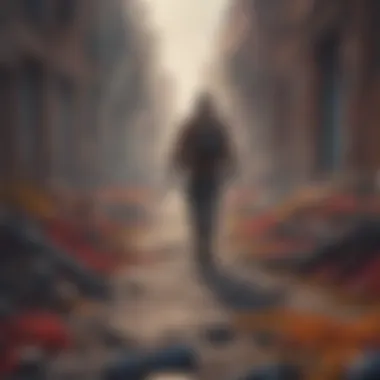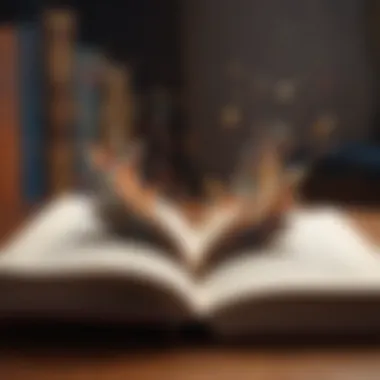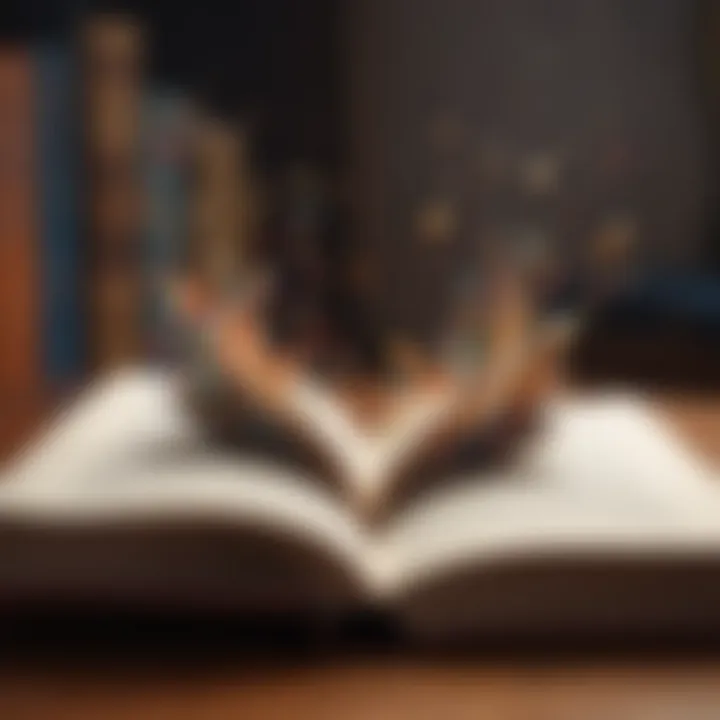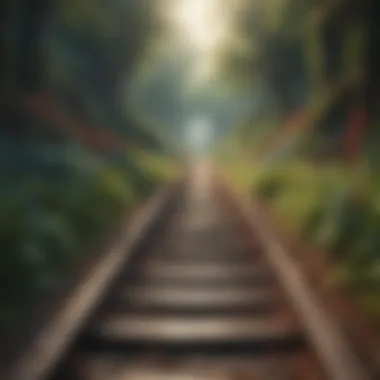Discovering Insights from 'The War of Art' Audiobook


Intro
In the vast landscape of creativity, struggles and triumphs often walk hand in hand. The War of Art, penned by Steven Pressfield, stands as a beacon for those grappling with their artistic endeavors. More than just a book, the audiobook format adds layers to its depth, allowing listeners to absorb its nuances while engaged in other tasks. For many, this experience prompts a visceral reflection on their own resistance to creativity—a daily battle many face.
Within this analysis, we will embark on a journey, peeling back the layers of resistance embodied within the pages of this work. With insights from the audiobook, we hope to kindle the flame of inspiration in artists, be they professionals or aspiring creators.
Prepare to dive into the potent themes of creativity and resistance, and together, we will explore practical pathways for overcoming hurdles that stifle our creative expression.
Key Concepts and Insights
Main Ideas from the Book
The essence of The War of Art revolves around the term Resistance, which Pressfield defines as the relentless force that combats creativity. Understanding this concept is crucial, as it manifests in various forms: fear, procrastination, and self-doubt among them. Through the lens of the audiobook, these ideas resonate deeper, as listeners can absorb Pressfield’s tone and urgency — an almost battle cry for creators.
Key themes include:
- Resistance Defines Our Path: Every creative seeks to push past their limits, but Resistance works tirelessly against it. Recognizing this is the first step.
- Creativity as a Profession: Pressfield advocates treating creativity like a job. Approaching it with discipline — showing up consistently — is vital.
- The Artist’s Journey: Pressfield also underscores that success is not a destination; it is a continuous journey of growth through struggles and victories.
Practical Applications of Concepts
This grasp of resistance leads us to practical measures. Embracing a daily routine can help mitigate the effects of Resistance. Here are some strategies that can aid the practice:
- Set specific, achievable goals: Break larger projects into bite-sized tasks. This minimizes the overwhelm and combats procrastination.
- Create a dedicated workspace: Now, I am not saying it has to be a grand studio, but carve out a nook where creativity thrives.
- Cultivate self-awareness: Recognizing your patterns of Resistance can empower change. Journaling can be an effective tool in this respect.
“The more important a call or action is to our soul's evolution, the more Resistance we will feel toward pursuing it.” - Steven Pressfield
Recommendations and Further Reading
To further bolster your journey as an artist, here are a few recommendations worth exploring:
Related Books to Explore
- Bird by Bird by Anne Lamott: This book offers insights into writing and creativity, providing both humor and wisdom.
- The Artist's Way by Julia Cameron: A guide to nurturing creativity in all forms, worth every moment.
- Steal Like an Artist by Austin Kleon: This book encourages blending influence and originality, especially potent for those in creative slumps.
Additional Resources for Personal Development
Platforms like Reddit can provide vibrant discussion and community engagement for aspiring artists. Subreddits such as r/writing or r/art can prove beneficial as they nurture supportive environments for sharing ideas and struggles. Visiting reputable sites like Britannica and Wikipedia for research on influence and development in art can also broaden your perspectives.
In summary, the audible experience of The War of Art offers profound lessons for navigating resistance. With its key concepts and actionable applications, listeners can find not just inspiration but a pathway to artistic freedom.
Intro to 'The War of Art'
In the ever-evolving realm of creativity, 'The War of Art' stands as a beacon illuminating the multifaceted struggles that artists face. This book grapples with a common enemy: resistance. Understanding resistance, its forms, and how it manifests in our lives is vital for anyone hoping to carve their path in the artistic landscape. This introduction aims to frame the importance of this exploration, capturing the essence of how the concepts discussed in the book resonate deeply with modern listeners.
Navigating the art of creation is not merely about applying techniques or honing skills. It's a deep dive into the psyche, where battles against self-doubt and procrastination rage unceasingly. For aspiring creators, professionals, or anyone hesitant to pursue their passions, knowing why they hesitate is crucial in overcoming hurdles.
About the Author
The mind behind this transformative text is Steven Pressfield, an author whose own journey involved wrestling with resistance before he found his footing. Before embarking on his writing career, Pressfield navigated various jobs—from waitressing to screenwriting—each a reflection of both struggle and resilience. His personal narrative is woven into the very fabric of 'The War of Art.'
One might say Pressfield has been through the wringer, and it is precisely this experience that lends weight to his insights. His crossing from an amateur mindset to a full-fledged professional exemplifies the principles he espouses, making his words resonate with authenticity. Pressfield has not just theorized about resistance; he has battled it firsthand, emerging with invaluable strategies to defy it.
Overview of the Book's Themes
A summary of 'The War of Art' without delving into its thematic depth would be akin to a ship sailing without a compass. The core themes encompass:
- Resistance as a Universal Struggle: The enemy that many face but few truly comprehend. Resistance is not merely external; it takes root within, challenging one's journey toward creativity.
- The Artist's Path: A focus on embracing the identity as an artist involves recognizing the work's inherent value and embracing the discipline it requires.
- Professionalism vs. Amateurism: Transitioning from treating art as a hobby to viewing it as a profession is essential for achieving one’s goals.
These themes ebb and flow throughout the audiobook, revealing layers of understanding that encourage action rather than despair.
Significance of the Audiobook Format
The format of 'The War of Art' as an audiobook holds particular significance. Listening to Pressfield’s words—sometimes soft, sometimes fervent—adds a layer of intimacy to the experience. Audiobooks enable a deeper connection, allowing the listener to absorb the material in a more personal manner compared to traditional reading.


Through its format, listeners are not just passive receivers of information; they actively engage with the material. This dynamic enhances their relationship with the core messages, offering moments of reflection that can be easily overlooked in print.
As we move into the subsequent sections, keep in mind that understanding resistance is only the start. Knowing how to navigate one's creative journey and utilize the lessons offered by Pressfield can lead to personal revolution.
Resistance: The Central Conflict
Resistance is the crux of the artistic struggle embodied in Steven Pressfield's insights. It not only challenges creativity but also serves as a mirror reflecting our deepest fears and hesitations. Throughout this article, the concept of resistance will be dissected into its multifaceted forms and the subtle ways it manifests in our lives. Understanding resistance is paramount, as it serves as both an adversary and a teacher. By recognizing and ultimately grappling with resistance, creators can begin to clear their paths to artistic expression and personal growth.
Defining Resistance
At its core, resistance is defined as the internal force that pushes against our desire to create. It often arises at the most critical moments, sabotaging our best intentions. It's that nagging voice that whispers doubts and discouragement when we sit down to write or pick up a brush. Pressfield personifies resistance as an enemy that does everything in its power to keep us from achieving our goals. This conflict isn’t simply an artist’s plight; it is a universal struggle confronted by anyone chasing ambitions.
Forms of Resistance
Resistance may rear its ugly head in various forms, each exhibiting distinct characteristics.
Fear
Fear paralyzes many aspiring artists. Whether it's fear of failure, judgment, or simply not meeting expectations, it looms large. This form of resistance prevents individuals from taking the first step towards creation. Fear is relatable and often acknowledged in this article, as it is a common human experience. By naming fear, discussing its consequences, and learning to confront it, we dissect a barrier that holds great significance in the creative process. The unique feature of fear is its capacity to cloud judgement. While it warns of potential danger, it can also stifle innovation, leading to stagnation in personal and artistic development.
Procrastination
Procrastination is another sneaky variant of resistance. It feeds off our initial enthusiasm, gradually leading us into a pit of inaction. It is often disguised as a form of productivity; scrolling through social media or organizing a workspace can be shiny distractions. Procrastination carries a double-edged sword quality; while it allows the mind to wander and gather ideas, it can also spiral into total avoidance of tasks that matter. Hence, in relation to this article, we address how recognizing procrastination can lead to the establishment of a more disciplined approach toward achieving our creative goals.
Perfectionism
Perfectionism can be one of the trickiest forms of resistance. It’s the convincing whisper that if the outcome isn’t flawless, it isn’t worth pursuing at all. Artists who fall prey to perfectionism may find themselves stuck in a cycle of endless revisions rather than completing their work. This mindset can radiate a sense of pride, but it often perpetuates an endless dream rather than a tangible reality. In exploring this form of resistance, we highlight its tendency to inhibit creativity and the importance of authenticity over infallibility.
Self-Doubt
Self-doubt is perhaps the most insidious form of resistance. It creeps up uninvited, raising questions about one's talent, credibility, and worth. Self-doubt can sometimes feel like a cold blanket wrapped tightly around one's ambitions, inhibiting the light of creativity. Its key characteristic lies in its ability to disguise itself as humility, masking true potential. This article will not shy away from examining self-doubt's pervasive influence, portraying it both as a formidable foe and a potential catalyst for resilience through acknowledgment and reflection.
Resistance in Daily Life
Resistance manifests in our daily routines, affecting both personal and professional spheres. Individuals find themselves watching the clock tick while creativity slips away unnoticed. To recognize resistance in these mundane moments is key to overcoming it. One practical strategy discussed here involves creating mindful rituals that acknowledge resistance but choose to work through it—inviting a practice that honors progress over perfection. Incorporating methods like journaling, setting small, achievable goals, or simply allowing oneself to fail can pave the way for more productive engagement with creativity, irrespective of the task at hand.
"The more important a call or action is to our soul's evolution, the more Resistance we will feel toward pursuing it."
In closing this section, it’s evident that the struggle against resistance is not only a barrier but also a necessary rite of passage for anyone on a creative journey. Understanding these forms of resistance equips us to tackle them head-on, establishing a path toward growth that transcends mere creative expression.
The Artist's Journey
The journey of an artist is not just a whimsical path of creativity; it’s often a rugged road filled with obstacles, self-doubt, and a relentless pursuit of excellence. In this context, exploring 'The War of Art' sheds light on the essence of this journey. This section aims to break down the aspects of embracing one's role as an artist, the discipline required in this vocation, and the challenge of staving off creative blocks, all pivotal in helping artists navigate their unique journeys.
Embracing the Role of the Artist
To engage fully in the world of creativity, one must first accept the identity of an artist. This acceptance involves recognizing that art is not solely an act but rather a calling. In the audiobook, the notion of taking on this role is an invitation to acknowledge the art within oneself. This journey is both personal and universal, reflecting our inherent need to express and create.
When an individual embraces the artist's role, they open the floodgates to inspiration and vulnerability. It's about standing tall in the face of critiques, societal expectations, and the self-imposed barriers that often arise. This can feel like walking through a minefield on occasion, but having the courage to call oneself an artist is a significant step toward self-actualization and fulfillment.
Cultivating Discipline and Routine
Discipline and routine are the backbone of any artist's practice. They transform fleeting moments of inspiration into tangible progress. The importance of consistency can't be overstated; it's often the difference between an artist who merely dreams and one who creates significant work.
The Importance of Consistency
Consistency acts like the plow that breaks the ground for new ideas. For artists, establishing a routine serves to nurture creativity rather than stifle it. This creates an expectation, not just for oneself but for the surrounding environment, that creativity will flow through regular practice.
Highlights of this aspect include:
- Key Characteristic: A commitment to showing up, whether inspiration strikes or not.
- Beneficial Choice: Consistency breeds confidence; the more one practices, the easier it gets to tap into creativity.
- Unique Feature: It allows for a gradual building of skills and development of one's unique voice over time.
- Advantages: Artists often find that through regular work, they discover unexpected avenues of creativity and clarity, leading to breakthroughs that random bursts of inspiration alone may not yield.
Creating a Productive Environment
A barren room will yield barren thoughts. The environment in which an artist creates can greatly affect their productivity. Creating a productive environment is a conscious decision and essential for fostering creativity. Consider an artist’s workspace: it should reflect personal aesthetics that inspire and energize.


Key elements include:
- Key Characteristic: An environment that minimizes distractions while encouraging flow.
- Beneficial Choice: A well-designed space can significantly increase the efficiency of creative efforts.
- Unique Feature: The ability to customize one’s workspace to suit particular needs or moods, incorporating items that spark joy or motivation.
- Advantages: It’s natural to want to create in a space that feels inspiring and comfortable. This makes the act of creating less of a chore and more of a delightful habit.
Navigating Creative Blocks
Creative blocks are the dreaded speedbumps on the artist's journey. They can manifest as self-doubt, fear, or fatigue, often leading to a standstill in production. Yet, 'The War of Art' teaches us that these blocks are not just hindrances; they are part and parcel of the creative life.
Artists must learn strategies to navigate through these tough patches. It might involve stepping back, engaging in different creative pursuits to refresh one's perspective, or practicing mindfulness to clear the mental clutter. Handling blocks requires resilience, a willingness to confront one’s inner critic, and often, simply the act of continuing to create, no matter how small the effort.
In sum, the journey of an artist, framed by the discussions in 'The War of Art', resonates deeply with the challenges and triumphs faced during the creative process. Acceptance, discipline, environment, and navigating blocks are essential threads in the fabric of an artist's development and achievement.
The Power of Professionalism
Professionalism holds a unique place in the discourse surrounding creativity, especially as outlined in 'The War of Art.' Here, professionalism is depicted not merely as a badge of honor, but as a fundamental mindset that can separate successful artists from mere dabblers. When one embraces professionalism, they shift from being an amateur, who may only indulge in creative pursuits sporadically, to a determined professional who is committed, focused, and diligent. This transition is not just about honing skills; it’s a layered process that intertwines personal growth with artistic development.
One crucial element is the commitment to one’s craft. Understanding that artistry goes beyond mere talent is significant. A professional artist recognizes that creativity must be nurtured through sustained effort, time-management, and discipline. This level of commitment fosters a productive environment conducive to creating consistent work, thereby enhancing one’s ability to navigate the inevitable hurdles of artistic expression.
Transitioning from Amateur to Professional
The gap from being an amateur to a professional can feel like leaping across a chasm littered with self-doubt and fear. An amateur often flits from one creative endeavor to another, while a professional focuses on mastery of a particular skill. Taking the plunge often involves admitting that the journey may not always be easy. However, establishing a clear intention to grow can encourage artists to confront their fears head-on, emphasizing that true artists evolve through continuous learning.
A clear path involves these steps:
- Defining clear objectives: Understanding what it means to you personally to be a professional.
- Regular practice: Like any profession, art requires daily dedication.
- Seeking feedback: It’s essential to engage with others and ask for constructive criticism, which is a hallmark of professional growth.
Accountability in Creative Pursuits
When discussing accountability in creative endeavors, it's crucial to recognize that being accountable can act as a catalyst for success. Accountability structures the creative process, forcing artists to remain on task and fulfill commitments, both to themselves and to their audience.
Setting Goals
Setting goals presents an undeniable framework for creativity. It prompts the artist to establish clear, tangible benchmarks that direct their actions. The main characteristic here is specificity—rather than saying, "I’ll paint more," a professional might outline, "I’ll complete three paintings by the end of the month."
Such specificity is not just beneficial; it’s vital. It fosters a sense of ownership and responsibility. Setting goals pushes an artist to confront their barriers, providing a roadmap against procrastination. One distinctive feature about goal-setting is that it can be adjusted as needed, which can be both an advantage and a disadvantage. If goals become too rigid, they can create unnecessary pressure, but when adjusted wisely, they can foster continual improvement.
Tracking Progress
Tracking progress serves as a mirror, reflecting both achievements and areas that need improvement. By regularly assessing one's work, an artist can maintain a pulse on their growth. A key characteristic of this practice is its ability to celebrate small victories along the way. It is beneficial because it encourages positive reinforcement, which can be motivating and energizing for the creative soul.
The drawback, however, is that constant scrutiny can lead to self-criticism if not managed well. Artists might risk getting bogged down in the details of their progress rather than reveling in the joy of creation. Thus, it’s vital to strike a balance—to celebrate progress without losing sight of the overarching goals.
Through professionalism, transitioning from an amateur to a dedicated artist becomes an attainable journey. By holding oneself accountable through setting goals and tracking progress, individuals can navigate the complexities of the creative world, all while honoring their unique artistic vision. Ultimately, adopting this professional mindset, as suggested in 'The War of Art,' provides a solid foundation for sustained artistic growth.
The Influence of Mindset
In the context of 'The War of Art,' mindset can be the cornerstone of creative success or the very barrier that holds many back. Shifting one's mindset can significantly alter perspectives toward art, productivity, and personal growth. The importance lies not only in how artists view their craft but also in how they see themselves in the broader canvas of life. A nurturing mindset encourages exploration, risk-taking, and resilience, while a negative mindset can lead to stagnation and frustration.
Adopting an Abundance Mentality
Adopting an abundance mentality refers to the belief that there is plenty of success, creativity, and opportunity to go around, as opposed to a scarcity mentality, which operates under the assumption that if someone else succeeds, it diminishes one’s own chances. In the realm of creativity, embracing this view can open a floodgate of possibilities. Here are few key elements of an abundance mentality:
- Collaboration over Competition: When you're willing to share ideas and work with others, it can lead to richer experiences and outcomes.
- Learning from Others: There’s always something to gain from someone else's success story rather than feeling envious. This can lead to inspiration instead of intimidation.
- Endless Growth: An abundance mindset suggests that growth and improvement are lifelong pursuits. It shifts focus from limited outputs to continuous personal and professional development.
Incorporating these principles can transform the inner dialogue one has about their work, leading to a more productive and fulfilling creative journey.
Overcoming Limiting Beliefs
Limiting beliefs can sneak into the creative process like uninvited guests. These are the thoughts that undermine one's potential, such as "I'm not good enough" or "I don't have what it takes." Overcoming these beliefs is crucial for anyone looking to make progress in their artistic endeavors. Here are a few strategies to dismantle these mental barriers:
- Identify the Beliefs: Recognizing them is the first step. Write them down and examine their origin. Are they based on reality, or are they simply fear-based assumptions?
- Challenge Negative Thoughts: Replace limiting thoughts with affirmations. For instance, instead of thinking, "I can’t write a book," shift to "I’m capable of sharing my story."
- Seek Feedback: Constructive criticism can shed light on strengths that limiting beliefs might overshadow. Talking to peers or mentors can provide valuable perspective.
- Practice Resilience: Building resilience through small, manageable risks can strengthen the mindset. Celebrate small wins that counteract those negative thoughts.
By tackling limiting beliefs head-on, one can create a mental environment conducive to creativity, leading to higher productivity and improved satisfaction in the artistic journey.
"The mind is everything. What you think you become." - Buddha


In essence, nurturing a robust mindset is essential for anyone looking to conquer the inner battles of creativity. By embracing an abundance mentality and actively working to overcome limiting beliefs, artists can pave the way for incredible growth and creative achievement.
Insights from the Audiobook Experience
In today's fast-paced world, the way we consume information has shifted dramatically. Audiobooks have emerged as a popular medium, merging convenience with rich content engagement. When it comes to The War of Art, experiencing the audiobook version encapsulates not just the text, but the nuances of delivery which can significantly deepen a listener's understanding and connection to its themes. Listening versus reading isn't merely a question of format; it's an experience that can color the way we perceive the author's intent and emotional weight.
Effective Narration Techniques
Narration plays a pivotal role in how material is received. A well-narrated audiobook can transform dense concepts into vivid images, and Roberta Hass’s delivery of The War of Art is a case in point. Here are a few techniques that stand out:
- Pacing: The rhythm of Hass's voice strikes a balance between urgency and contemplation, allowing listeners to absorb profound insights without feeling rushed.
- Inflection and Tone: The subtle shifts in her tone align with the emotional weight of the content, making the listener more attuned to moments of struggle and triumph.
- Emphasis: Key phrases are pronounced with distinct emphasis, which helps to reinforce the book's core messages about resistance and creativity.
These elements work collectively to enhance comprehension and stimulate reflection, making it easier for listeners to apply the lessons to their own creative journeys.
Guided Reflections and Takeaways
One of the benefits of absorbing The War of Art as an audiobook is the opportunity for guided reflections. At various intervals, listeners are prompted to pause and consider how the messages resonate personally. Some key takeaways include:
- Personal Accountability: The audiobook encourages listeners to actively engage with their own creative impulses and resistances.
- Mindset Shifts: The importance of cultivating a growth mindset is emphasized repeatedly, suggesting that understanding and welcoming resistance can be transformative.
- Action-Driven Reflections: Aside from intellectual knowledge, listeners are nudged toward action steps that can enhance their own practices, such as setting specific goals related to their creative work.
"Resistance cannot be seen, touched, heard, or smelled. It is the most toxic force on the planet. It is experienced by every human being who has a talent or gift to share."
These reflections not only deepen the audience's grasp of the material but intertwine seamlessly with their individual journeys as creatives and dreamers. As they listen, they become participants in a dialogue that compels them to consider their own failures and victories.
Through listening to The War of Art, one doesn't just learn about creativity; rather, they embody it. The audiobook format not only serves as a vessel for knowledge but as a catalyst for personal growth and transformation.
Practical Applications of the Concepts
Delving into the practical applications of the concepts presented in 'The War of Art' illuminates how the book's rich wisdom can be seamlessly woven into everyday life. The emphasis on action, rather than mere contemplation, stands as a cornerstone in this discourse. By not only understanding the theory behind resistance but also actively combatting it through tangible actions, individuals can transform their creative aspirations into reality. Each concept discussed in the book is not merely theoretical but is infused with the potential for real-world impact, thereby enriching one's life and creative practices.
Integrating Lessons into Daily Life
Integrating the lessons from 'The War of Art' into daily life is akin to nurturing a small seed into a thriving tree. It requires intention, patience, and consistency. Here are some ways to bring these lessons into everyday routines:
- Mindful Scheduling: Carve out specific times dedicated to creative endeavors. Just as an artist wouldn’t leave their canvas unattended indefinitely, setting aside regular time slots can create an environment ripe for creativity.
- Daily Reflection: Take a few moments at the end of each day to reflect on what resistance you faced. Jotting down your thoughts can help identify patterns in your resistance, allowing you to tackle it head-on.
- Accountability Partnerships: Partnering with a friend or colleague can create a support network. Discussing each other's goals can instill motivation and offer new perspectives.
- Embracing Discomfort: Cultivating a tolerance for discomfort encourages growth. Engaging in tasks that stretch your abilities will build resilience against self-doubt and procrastination.
Creating a Personal Action Plan
Creating a personal action plan rooted in the principles of 'The War of Art' allows for structured progress. Developing this plan demands introspection, commitment, and an understanding of one’s individual goals. Here are steps to outline your action plan:
- Define Your Purpose: What drives your creative endeavors? Outlining a clear purpose can anchor your efforts and keep distractions at bay.
- Set Specific Goals: Setting both short-term and long-term goals helps in mapping out the journey. Consider what you want to achieve in one month, six months, or even one year.
- Break It Down: Large projects can seem daunting. By breaking them into smaller, manageable tasks, you can systematically approach each part without feeling overwhelmed.
- Establish Routine Check-ins: Designate regular intervals to assess your progress. Are you moving towards your goals? What adjustments are necessary to stay aligned?
- Celebrate Small Wins: Recognizing milestones along the way can foster a sense of accomplishment and motivation to continue.
"A Parisian individual once said, 'The best way to get something done is to begin.' Action is the antidote to resistance."
Closure: Beyond Resistance
In contemplating the journey through "The War of Art," it becomes increasingly clear that the struggle against resistance is just one portal into the broader, more enriching realm of personal growth and artistic expression. The conclusion invites us not simply to reflect on the battles we face but to recognize the potential that lies beyond them. By acknowledging resistance as a common foe, we set the stage for mastering our creative endeavors. The importance of this topic cannot be overstated; it serves as a rallying cry for all aspiring artists and professionals alike.
The insights gained from this exploration empower the listener. Initially, encountering resistance may feel like an insurmountable wall. However, overcoming this hurdle is where personal transformation occurs. It is not merely about pushing through; it’s about understanding the constructive role these struggles have in shaping our identity and capabilities.
Reflecting on Personal Growth
Reflecting upon personal growth emerges as a vital aspect of moving beyond resistance. Growth isn’t a straight line, but a complex web of experiences that forge our character. Those who listen to the audiobook can appreciate the importance of self-reflection. By digging into one's experiences, one often uncovers deeper insights about motivations and desires.
Here are some reflections to consider:
- Identify Past Resistance: Acknowledging instances of resistance in one's life can lead to valuable lessons. Understanding how you responded can reveal patterns that might still hold sway.
- Celebrate Small Victories: Celebrating even the minutiae—such as completing a project or overcoming procrastination—fosters a sense of accomplishment and fuels further growth.
- Develop a Growth Mindset: Embracing the philosophy that abilities can be developed through hard work and perseverance plays a critical role. This concept pushes us to view failures not as setbacks but as opportunities to learn.
Shifting the focus from what hinders us to what elevates us opens the door to a fresh outlook on our work and life. It’s this very shift that can ignite creativity and allow for richer expression.
Continued Learning and Development
Emphasizing the idea of continued learning and development highlights that the journey does not cease with the defeat of resistance. Life is dynamic, and so is the pursuit of artistic endeavors.
Some paths to consider for ongoing development include:
- Formal Education: Engaging in workshops, courses, or even online tutorials ensures that the creative toolkit remains diverse and up-to-date.
- Networking and Collaboration: Surrounding oneself with other creative minds introduces new ideas and perspectives. Sharing experiences can offset feelings of isolation and increase motivation.
- Consistent Practice: Developing a discipline of regular practice allows for the continuous honing of skills. Whether writing, painting, or producing music, consistency is key to becoming proficient.
"The only way to discover the limits of the possible is to go beyond them into the impossible."
—Arthur C. Clarke
Through these continuous efforts, artists can cultivate resilience and adaptability in the face of future obstacles. As the concluding section of this exploration, it serves as a reminder: success is not solely defined by the absence of resistance, but by the commitment to grow and learn in its presence.







